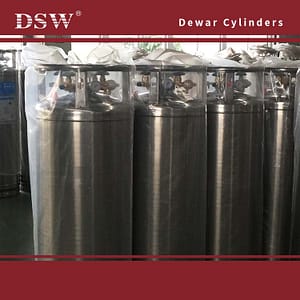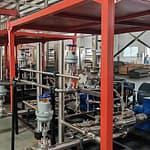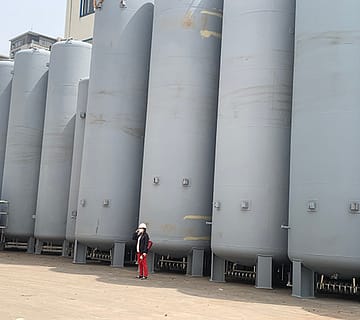Cryogenic Storage Vessel
The global cryogenic vessels market is expanding, particularly in emerging markets like China, India, and the United States. These regions are investing in cryogenic infrastructure to support industries like medical research, gas production, and space exploration. In healthcare, cryogenics is used for oxygen therapy and cryosurgery, while the space and renewable energy sectors also drive demand.
This guide will provide tips on selecting and maintaining cryogenic storage vessels. Whether for medical, industrial, or transportation purposes, these tips will help ensure your vessels are reliable, efficient, and safe. With our expertise, we aim to help industries choose the right equipment that meets their needs while ensuring compliance with safety standards.
What Is A Cryogenic Vessel?
Cryogenic vessels are special containers that store and transport liquid gases at extremely low temperatures, usually below -150°C (the boiling points of gases like oxygen, nitrogen, and argon). These vessels are often used in industries where gases must be liquid for storage, transit, or various applications, including the medical, industrial, scientific, and aerospace sectors.
Why Are Cryogenic Vessels Important?
Cryogenic pressure vessels allow gases, typically in gaseous form under standard atmospheric conditions, to be converted into liquids. This makes storing and transporting large volumes of these gases more efficient, which is crucial for industries that rely on these gases in liquid form. For example, liquid nitrogen is commonly used in food freezing, cryopreservation, and as a coolant, while liquid oxygen is essential in medical settings for oxygen therapy and life support.

Types of Cryogenic Vessels
Cryogenic vessels are available in various configurations; a prevalent design features double-walled cylindrical containers, wherein the inner tanks are constructed from stainless steel and the outer tanks are composed of carbon steel, both of which are filled with an insulating material. High-vacuum configurations are implemented to reduce thermal losses.
The selection will be contingent upon the particular fluid it encompasses and the requisite dimensions and storage capacity. Typical configurations for Cryogenic vessels come in several types, each suited for different applications and gas storage requirements:
- Laboratory Storage Jars
- Cryogenic Storage Containers
- Dewar Flasks
- Cryogenic Vessels
- Cryogenic Storage Tanks
- Flat-Bottom Cryogenic Tanks
- Cryogenic Transport Trailer
- ISO Cryogenic Containers
- Pressurized Cryogenic Storage Tanks
- High-Pressure Cryogenic Vessels

Main Feature
These cryogenic storage vessels must be tailored to meet the specific environmental and operational conditions they will face, including location, weather, soil type, and the properties of the stored cryogenic liquid. Whether storing liquid nitrogen (LN2), oxygen (LOX), argon (LAR), or liquefied natural gas (LNG), the vessel’s design must ensure both safety and efficiency under extreme conditions. Below, we investigate the principal elements and technical issues defining the performance of cryogenic containers.
- Inner vessel, including cryogenic fluid
Since a cryogenic vessel comes into direct touch with the frozen cryogenic liquid, the inner vessel is the most essential component of one. This part has to resist relatively low temperatures without sacrificing its structural integrity.
• Material Choice: Usually composed of stainless steel alloys—such as 316L or 304L (X5CrNi18-10 AS PER DIN 10028-7 OR EQU) & design code EN 13530 – 2002—which are specially selected for their resistance to low-temperature embrittlement, tensile strength, and durability—the inner vessel is These materials guarantee safe storage and transit of cryogenic fluids by offering extraordinary resistance to cracking.
• Manufacturing Precision: Modern manufacturing methods like stress-relieving procedures and welding are applied to guarantee the strength of the inner vessel. Baffles and internal divisions are often included to keep the liquid stable and lower the possibility of sloshing or strong fluid movement, affecting pressure levels and safety. - Outer vessel: the insulating Vacuum jacket
Often known as the vacuum jacket, the exterior vessel minimizes heat transfer from the external environment to provide essential insulation, keeping the cryogenic liquid at its intended temperature. The insulation is crucial for ensuring efficiency since heat infiltration could cause vaporization and loss of goods.
• Material Composition: The exterior vessel is usually built of carbon steel & design code EN 13530:2002 or occasionally galvanized steel for maximum corrosion resistance in demanding surroundings. Specific designs also make use of stainless steel for maximum lifetime.
• Space vacuum: The main insulating layer is a vacuum between the inner and outer vessels, significantly lowering thermal conductivity. Larger boats may use perlite or multi-layer insulation (MLI) to improve performance. Some sophisticated designs feature vacuum-insulated panels (VIPs) to increase thermal efficiency further.
• Environmental Resistance: The outside vessel must also resist environmental elements, including temperature swings, UV light, and moisture. Safety and long-term performance can be guaranteed using specialized coatings and corrosion-resistant materials. - Minimizing Heat Transfer: Insulation System
Maintaining low temperatures for cryogenic storage depends critically on the insulating system. Most big-scale cryogenic tanks combine elements to stop heat from getting into the vessel and boiling off the liquid.
The most often used type of insulation is the vacuum space between the inner and outer vessels; some designs also use other thermal insulating materials, including polyurethane foam, glass wool, or perlite, to offer better insulating capacity.
• Substitute insulating systems: Advanced solutions, such as multi-layer thermal blankets or cryogenic flexible insulation, can be used for applications involving very low temperatures or unique needs. - Maintaining Safe Pressure Levels: Pressure Regulation System
Specialized pressure regulating devices built to guarantee that the pressure inside the vessel stays within safe operating limits equip cryogenic vessels. Maintaining the integrity of the tank and ensuring the security of the kept cryogenic liquid depends on this.
• Valves for pressure release: Stopping over-pressurization—which can cause catastrophic failure—depends on these valves. Designed to release gas when pressure rises above a specified level automatically, pressure relief valves guard the vessel and the nearby surroundings.
• Safety mechanisms: Apart from redundant pressure control systems, burst discs, and pressure relieving valves, other levels of protection are usually provided. These devices guarantee that the pressure within the vessel stays at a safe level, even in the case of a breakdown.
• Systems of Monitoring: Usually featuring automatic pressure monitoring systems that give operators real-time data, modern cryogenic tanks are used. These technologies prevent unanticipated changes that can compromise the stored gas or the surrounding infrastructure and help the vessel’s pressure be matched to operational criteria.

Applications:
- Medical: Cryogenic vessels are widely used for storing medical gases such as liquid oxygen (LOX) for hospitals, oxygen therapy, and cryopreservation.
- Industrial: They are also used in industries where liquid gases like nitrogen (LIN) and argon (LAR) are required for welding, food freezing, and chemical production.
- Research and Science: Cryogenic vessels, including superconductivity and particle physics applications, are crucial in scientific research.
Custom Cryogenic Vessel Design and Solutions
DSW specializes in designing, manufacturing, installing, and maintaining cryogenic pressure vessels for various industries. Our products include flat-bottom cryogenic tanks, pressurized cryogenic storage tanks, and other types of cryogenic vessels.
We offer complete turnkey solutions, handling every step of your cryogenic project. Our team of engineers and technicians, supported by two fully equipped production facilities, ensures top-quality design and manufacturing.
With over 20 years of experience in cryogenic engineering, we also provide maintenance services for various cryogenic vessel types, including laboratory jars, dewars, rangers, and cryogenic tanks.
For more information on our cryogenic solutions, contact us today.








No comment